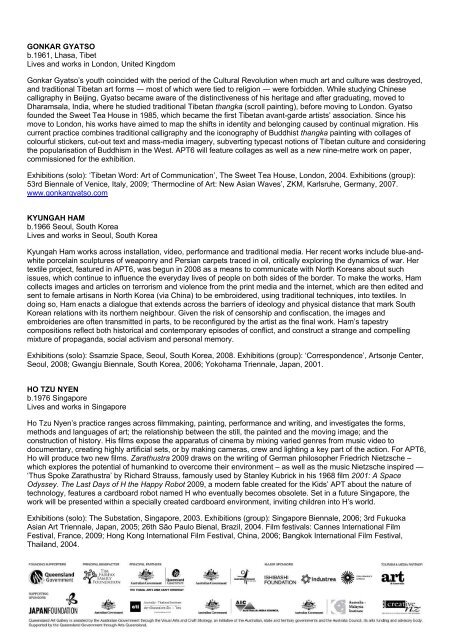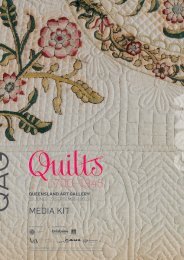MEDIA KIT - Queensland Art Gallery - Queensland Government
MEDIA KIT - Queensland Art Gallery - Queensland Government
MEDIA KIT - Queensland Art Gallery - Queensland Government
Create successful ePaper yourself
Turn your PDF publications into a flip-book with our unique Google optimized e-Paper software.
GONKAR GYATSO<br />
b.1961, Lhasa, Tibet<br />
Lives and works in London, United Kingdom<br />
Gonkar Gyatso’s youth coincided with the period of the Cultural Revolution when much art and culture was destroyed,<br />
and traditional Tibetan art forms ― most of which were tied to religion ― were forbidden. While studying Chinese<br />
calligraphy in Beijing, Gyatso became aware of the distinctiveness of his heritage and after graduating, moved to<br />
Dharamsala, India, where he studied traditional Tibetan thangka (scroll painting), before moving to London. Gyatso<br />
founded the Sweet Tea House in 1985, which became the first Tibetan avant-garde artists’ association. Since his<br />
move to London, his works have aimed to map the shifts in identity and belonging caused by continual migration. His<br />
current practice combines traditional calligraphy and the iconography of Buddhist thangka painting with collages of<br />
colourful stickers, cut-out text and mass-media imagery, subverting typecast notions of Tibetan culture and considering<br />
the popularisation of Buddhism in the West. APT6 will feature collages as well as a new nine-metre work on paper,<br />
commissioned for the exhibition.<br />
Exhibitions (solo): ‘Tibetan Word: <strong>Art</strong> of Communication’, The Sweet Tea House, London, 2004. Exhibitions (group):<br />
53rd Biennale of Venice, Italy, 2009; ‘Thermocline of <strong>Art</strong>: New Asian Waves’, ZKM, Karlsruhe, Germany, 2007.<br />
www.gonkargyatso.com<br />
KYUNGAH HAM<br />
b.1966 Seoul, South Korea<br />
Lives and works in Seoul, South Korea<br />
Kyungah Ham works across installation, video, performance and traditional media. Her recent works include blue-andwhite<br />
porcelain sculptures of weaponry and Persian carpets traced in oil, critically exploring the dynamics of war. Her<br />
textile project, featured in APT6, was begun in 2008 as a means to communicate with North Koreans about such<br />
issues, which continue to influence the everyday lives of people on both sides of the border. To make the works, Ham<br />
collects images and articles on terrorism and violence from the print media and the internet, which are then edited and<br />
sent to female artisans in North Korea (via China) to be embroidered, using traditional techniques, into textiles. In<br />
doing so, Ham enacts a dialogue that extends across the barriers of ideology and physical distance that mark South<br />
Korean relations with its northern neighbour. Given the risk of censorship and confiscation, the images and<br />
embroideries are often transmitted in parts, to be reconfigured by the artist as the final work. Ham’s tapestry<br />
compositions reflect both historical and contemporary episodes of conflict, and construct a strange and compelling<br />
mixture of propaganda, social activism and personal memory.<br />
Exhibitions (solo): Ssamzie Space, Seoul, South Korea, 2008. Exhibitions (group): ‘Correspondence’, <strong>Art</strong>sonje Center,<br />
Seoul, 2008; Gwangju Biennale, South Korea, 2006; Yokohama Triennale, Japan, 2001.<br />
HO TZU NYEN<br />
b.1976 Singapore<br />
Lives and works in Singapore<br />
Ho Tzu Nyen’s practice ranges across filmmaking, painting, performance and writing, and investigates the forms,<br />
methods and languages of art; the relationship between the still, the painted and the moving image; and the<br />
construction of history. His films expose the apparatus of cinema by mixing varied genres from music video to<br />
documentary, creating highly artificial sets, or by making cameras, crew and lighting a key part of the action. For APT6,<br />
Ho will produce two new films. Zarathustra 2009 draws on the writing of German philosopher Friedrich Nietzsche –<br />
which explores the potential of humankind to overcome their environment – as well as the music Nietzsche inspired —<br />
‘Thus Spoke Zarathustra’ by Richard Strauss, famously used by Stanley Kubrick in his 1968 film 2001: A Space<br />
Odyssey. The Last Days of H the Happy Robot 2009, a modern fable created for the Kids’ APT about the nature of<br />
technology, features a cardboard robot named H who eventually becomes obsolete. Set in a future Singapore, the<br />
work will be presented within a specially created cardboard environment, inviting children into H’s world.<br />
Exhibitions (solo): The Substation, Singapore, 2003. Exhibitions (group): Singapore Biennale, 2006; 3rd Fukuoka<br />
Asian <strong>Art</strong> Triennale, Japan, 2005; 26th São Paulo Bienal, Brazil, 2004. Film festivals: Cannes International Film<br />
Festival, France, 2009; Hong Kong International Film Festival, China, 2006; Bangkok International Film Festival,<br />
Thailand, 2004.
















